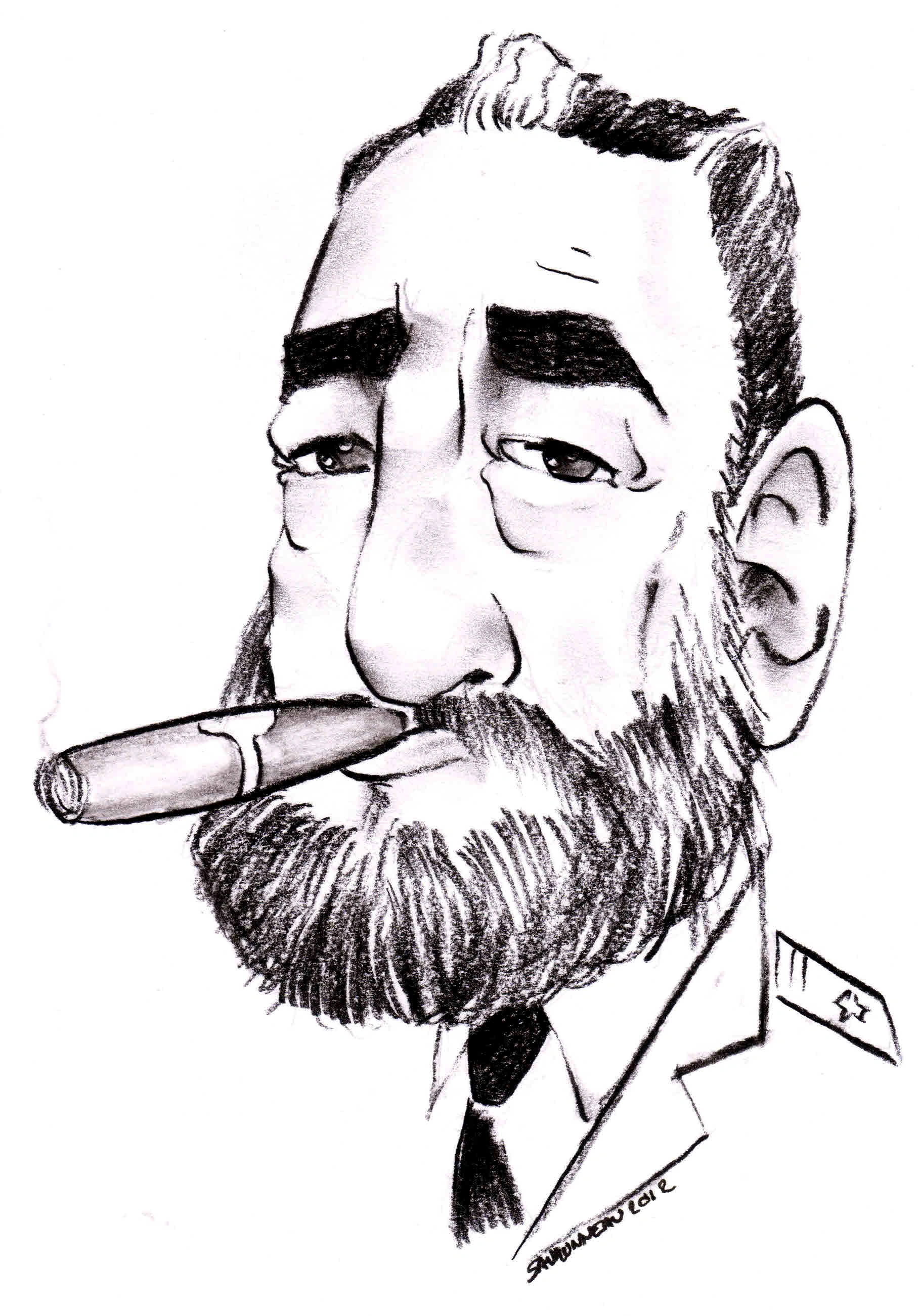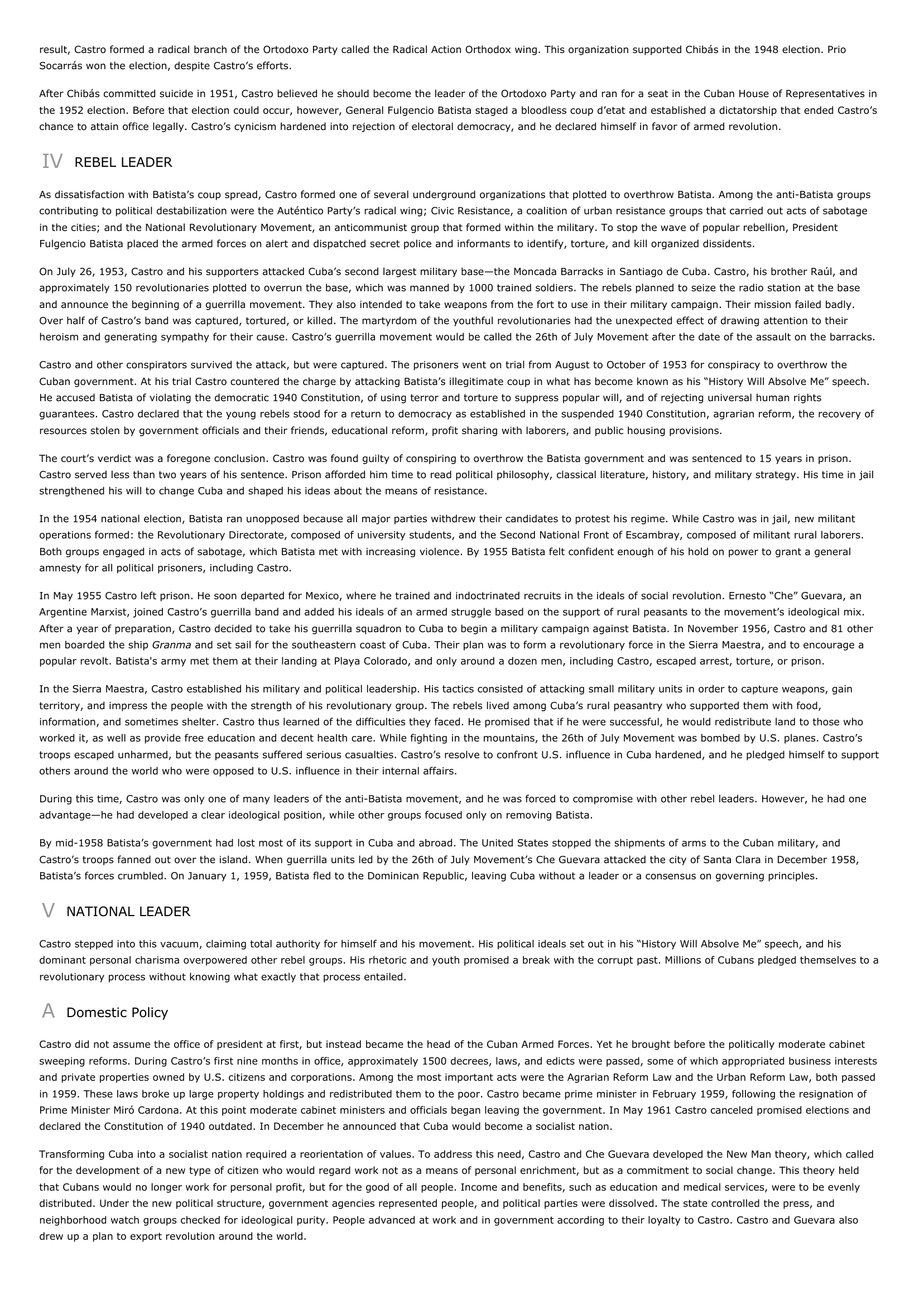Fidel Castro.
Publié le 03/05/2013

Extrait du document


«
result, Castro formed a radical branch of the Ortodoxo Party called the Radical Action Orthodox wing.
This organization supported Chibás in the 1948 election.
PrioSocarrás won the election, despite Castro’s efforts.
After Chibás committed suicide in 1951, Castro believed he should become the leader of the Ortodoxo Party and ran for a seat in the Cuban House of Representatives inthe 1952 election.
Before that election could occur, however, General Fulgencio Batista staged a bloodless coup d’etat and established a dictatorship that ended Castro’schance to attain office legally.
Castro’s cynicism hardened into rejection of electoral democracy, and he declared himself in favor of armed revolution.
IV REBEL LEADER
As dissatisfaction with Batista’s coup spread, Castro formed one of several underground organizations that plotted to overthrow Batista.
Among the anti-Batista groupscontributing to political destabilization were the Auténtico Party’s radical wing; Civic Resistance, a coalition of urban resistance groups that carried out acts of sabotagein the cities; and the National Revolutionary Movement, an anticommunist group that formed within the military.
To stop the wave of popular rebellion, PresidentFulgencio Batista placed the armed forces on alert and dispatched secret police and informants to identify, torture, and kill organized dissidents.
On July 26, 1953, Castro and his supporters attacked Cuba’s second largest military base—the Moncada Barracks in Santiago de Cuba.
Castro, his brother Raúl, andapproximately 150 revolutionaries plotted to overrun the base, which was manned by 1000 trained soldiers.
The rebels planned to seize the radio station at the baseand announce the beginning of a guerrilla movement.
They also intended to take weapons from the fort to use in their military campaign.
Their mission failed badly.Over half of Castro’s band was captured, tortured, or killed.
The martyrdom of the youthful revolutionaries had the unexpected effect of drawing attention to theirheroism and generating sympathy for their cause.
Castro’s guerrilla movement would be called the 26th of July Movement after the date of the assault on the barracks.
Castro and other conspirators survived the attack, but were captured.
The prisoners went on trial from August to October of 1953 for conspiracy to overthrow theCuban government.
At his trial Castro countered the charge by attacking Batista’s illegitimate coup in what has become known as his “History Will Absolve Me” speech.He accused Batista of violating the democratic 1940 Constitution, of using terror and torture to suppress popular will, and of rejecting universal human rightsguarantees.
Castro declared that the young rebels stood for a return to democracy as established in the suspended 1940 Constitution, agrarian reform, the recovery ofresources stolen by government officials and their friends, educational reform, profit sharing with laborers, and public housing provisions.
The court’s verdict was a foregone conclusion.
Castro was found guilty of conspiring to overthrow the Batista government and was sentenced to 15 years in prison.Castro served less than two years of his sentence.
Prison afforded him time to read political philosophy, classical literature, history, and military strategy.
His time in jailstrengthened his will to change Cuba and shaped his ideas about the means of resistance.
In the 1954 national election, Batista ran unopposed because all major parties withdrew their candidates to protest his regime.
While Castro was in jail, new militantoperations formed: the Revolutionary Directorate, composed of university students, and the Second National Front of Escambray, composed of militant rural laborers.Both groups engaged in acts of sabotage, which Batista met with increasing violence.
By 1955 Batista felt confident enough of his hold on power to grant a generalamnesty for all political prisoners, including Castro.
In May 1955 Castro left prison.
He soon departed for Mexico, where he trained and indoctrinated recruits in the ideals of social revolution.
Ernesto “Che” Guevara, anArgentine Marxist, joined Castro’s guerrilla band and added his ideals of an armed struggle based on the support of rural peasants to the movement’s ideological mix.After a year of preparation, Castro decided to take his guerrilla squadron to Cuba to begin a military campaign against Batista.
In November 1956, Castro and 81 othermen boarded the ship Granma and set sail for the southeastern coast of Cuba.
Their plan was to form a revolutionary force in the Sierra Maestra, and to encourage a popular revolt.
Batista's army met them at their landing at Playa Colorado, and only around a dozen men, including Castro, escaped arrest, torture, or prison.
In the Sierra Maestra, Castro established his military and political leadership.
His tactics consisted of attacking small military units in order to capture weapons, gainterritory, and impress the people with the strength of his revolutionary group.
The rebels lived among Cuba’s rural peasantry who supported them with food,information, and sometimes shelter.
Castro thus learned of the difficulties they faced.
He promised that if he were successful, he would redistribute land to those whoworked it, as well as provide free education and decent health care.
While fighting in the mountains, the 26th of July Movement was bombed by U.S.
planes.
Castro’stroops escaped unharmed, but the peasants suffered serious casualties.
Castro’s resolve to confront U.S.
influence in Cuba hardened, and he pledged himself to supportothers around the world who were opposed to U.S.
influence in their internal affairs.
During this time, Castro was only one of many leaders of the anti-Batista movement, and he was forced to compromise with other rebel leaders.
However, he had oneadvantage—he had developed a clear ideological position, while other groups focused only on removing Batista.
By mid-1958 Batista’s government had lost most of its support in Cuba and abroad.
The United States stopped the shipments of arms to the Cuban military, andCastro’s troops fanned out over the island.
When guerrilla units led by the 26th of July Movement’s Che Guevara attacked the city of Santa Clara in December 1958,Batista’s forces crumbled.
On January 1, 1959, Batista fled to the Dominican Republic, leaving Cuba without a leader or a consensus on governing principles.
V NATIONAL LEADER
Castro stepped into this vacuum, claiming total authority for himself and his movement.
His political ideals set out in his “History Will Absolve Me” speech, and hisdominant personal charisma overpowered other rebel groups.
His rhetoric and youth promised a break with the corrupt past.
Millions of Cubans pledged themselves to arevolutionary process without knowing what exactly that process entailed.
A Domestic Policy
Castro did not assume the office of president at first, but instead became the head of the Cuban Armed Forces.
Yet he brought before the politically moderate cabinetsweeping reforms.
During Castro’s first nine months in office, approximately 1500 decrees, laws, and edicts were passed, some of which appropriated business interestsand private properties owned by U.S.
citizens and corporations.
Among the most important acts were the Agrarian Reform Law and the Urban Reform Law, both passedin 1959.
These laws broke up large property holdings and redistributed them to the poor.
Castro became prime minister in February 1959, following the resignation ofPrime Minister Miró Cardona.
At this point moderate cabinet ministers and officials began leaving the government.
In May 1961 Castro canceled promised elections anddeclared the Constitution of 1940 outdated.
In December he announced that Cuba would become a socialist nation.
Transforming Cuba into a socialist nation required a reorientation of values.
To address this need, Castro and Che Guevara developed the New Man theory, which calledfor the development of a new type of citizen who would regard work not as a means of personal enrichment, but as a commitment to social change.
This theory heldthat Cubans would no longer work for personal profit, but for the good of all people.
Income and benefits, such as education and medical services, were to be evenlydistributed.
Under the new political structure, government agencies represented people, and political parties were dissolved.
The state controlled the press, andneighborhood watch groups checked for ideological purity.
People advanced at work and in government according to their loyalty to Castro.
Castro and Guevara alsodrew up a plan to export revolution around the world..
»
↓↓↓ APERÇU DU DOCUMENT ↓↓↓
Liens utiles
- Fidel Castro - Geschichte.
- Fidel o Castro
- Fidel Castro - historia.
- Fidel Castro par Jean-Claude Buhrer Correspondant du Monde, Paris Symbole de la première
- Castro, Fidel - biographie.













